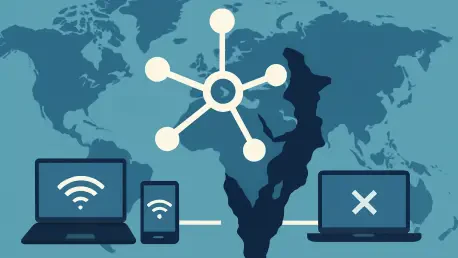In the vast landscape of the United States, where technology often seems ubiquitous, a stark digital divide persists, particularly among Tribal Nations, leaving many communities grappling with inadequate internet access that hinders their daily lives and future prospects. Despite the rapid pace of technological advancement, reliable high-speed connectivity remains elusive for numerous Native American communities, creating a barrier to essential services like education, telemedicine, and economic development. This gap is not merely a matter of inconvenience but a profound inequity that exacerbates historical challenges and limits opportunities for growth. Recent analyses, drawing on extensive data from tools like Ookla® Speedtest®, reveal a troubling disparity in both fixed and mobile broadband performance across 110 Tribal Nations compared to neighboring state averages. While some have achieved remarkable progress, many others lag far behind, trapped by systemic obstacles that demand urgent attention. This exploration seeks to uncover the depth of these connectivity challenges, examining the root causes, the impact of geography, and the potential solutions emerging from funding and innovative partnerships. By delving into the nuances of this issue, a clearer picture emerges of what is at stake and how targeted efforts might bridge this persistent divide, ensuring that no community is left disconnected in an increasingly digital world.
Unveiling the Digital Disparity
The extent of internet connectivity gaps in Tribal Nations becomes strikingly evident when examining the data, which paints a picture of profound inequality in access to high-speed broadband. A significant 36.4% of these communities report fixed download speeds below the Federal Communications Commission (FCC) benchmark of 100 Mbps, a threshold considered essential for modern usage. Even more concerning, 74.5% fall short of the median speeds recorded in their corresponding states, meaning that a majority struggle with internet performance that cannot support basic online activities like streaming or remote work. This disparity translates into tangible setbacks for residents who find themselves cut off from digital resources that many Americans take for granted. The frustration of slow or unreliable connections is a daily reality, underscoring a divide that is as much about equity as it is about technology.
On the flip side, there are glimmers of hope amid the challenges, as certain Tribal Nations have managed to surpass expectations with exceptional connectivity achievements. Nineteen of these communities boast fixed download speeds exceeding 300 Mbps, a testament to what can be accomplished with the right resources and strategies. Such successes, however, are far from universal, and they highlight the uneven landscape of digital access. The contrast between those thriving and those struggling raises critical questions about the underlying factors driving these differences. It becomes clear that while progress is possible, systemic barriers continue to hold many back, necessitating a deeper look into the specific hurdles that perpetuate this digital divide across Tribal lands.
The Weight of Geographic Isolation
Geography stands as one of the most formidable barriers to internet connectivity for many Tribal Nations, particularly those in remote or rugged regions where infrastructure deployment is a daunting task. Communities like the Kotzebue Tribe and Barrow (Utqiaġvik) in Alaska exemplify this struggle, situated in areas where harsh terrain and extreme isolation complicate even the most basic efforts to establish reliable networks. The logistical challenges of laying cables or erecting towers in such environments are immense, often requiring solutions that go beyond conventional approaches. These geographic realities create a persistent obstacle, ensuring that many residents remain disconnected from the digital world that others navigate with ease, amplifying feelings of exclusion in an era defined by online engagement.
Compounding these difficulties is the vulnerability of the limited infrastructure that does exist in such isolated locales, further deepening the connectivity crisis. Many remote Tribal Nations depend on systems like subsea fiber optic cables, which, while innovative, are prone to damage from natural elements or human activity, leading to frequent service disruptions. The high cost of repairs, coupled with the reluctance of private companies to invest in areas with low population density and high operational expenses, leaves these communities with little recourse. This cycle of neglect and underinvestment perpetuates a digital isolation that is as much a product of physical landscape as it is of economic priorities, demanding creative interventions to ensure that geography does not dictate digital destiny.
Harnessing Funding and Collaborative Efforts
Amid the challenges, federal funding and strategic partnerships have emerged as powerful catalysts for improving connectivity in Tribal Nations, offering a lifeline to communities long underserved by digital infrastructure. Programs such as the Tribal Broadband Connectivity Program (TBCP), which has allocated $1.8 billion to 226 Tribal entities by recent counts, provide critical resources for building and upgrading networks. These initiatives aim to close the digital gap by empowering communities to invest in the technology needed for high-speed internet. The impact of such funding is evident in the progress made by some Tribes, demonstrating that financial support, when effectively deployed, can transform the connectivity landscape and open doors to new opportunities for growth and development.
A shining example of this potential lies in the experience of the Zuni Tribe, whose collaboration with the Continental Divide Electric Cooperative has yielded remarkable results through targeted grant support. By leveraging significant funding, this partnership enabled the Zuni to achieve fixed download speeds of over 450 Mbps, far surpassing New Mexico’s median and setting a benchmark for what is possible. This success story illustrates the value of combining financial resources with local cooperation, creating a model that other Tribes might emulate. However, such outcomes are not guaranteed across the board, as access to funding and the ability to form effective partnerships vary widely. The disparity in results underscores the need for broader, more accessible support systems to ensure that all Tribal Nations can benefit from similar advancements.
Navigating Bureaucratic and Economic Hurdles
Even with funding opportunities available, many Tribal Nations face significant administrative obstacles that hinder their ability to improve connectivity, often delaying critical projects for years. The complexity of federal program applications, coupled with stringent reporting requirements, can overwhelm communities with limited staff or expertise, stalling progress before it even begins. A notable case is the Mashantucket Pequot Tribal Nation, whose TBCP-funded initiative, originally slated for completion several years ago, has been extended to 2026 due to bureaucratic setbacks. Such delays highlight a frustrating reality: financial resources alone are not enough if the systems to access and implement them are not streamlined or supported by adequate technical guidance.
Beyond administrative challenges, socioeconomic factors add another layer of difficulty, as many Tribal communities grapple with economic constraints that limit independent investment in digital infrastructure. Without the financial capacity to fund projects on their own, these Nations remain heavily reliant on external grants and partnerships, which are not always timely or sufficient to meet urgent needs. This dependency creates a precarious situation where progress hinges on the availability of outside support, often leaving smaller or less resourced Tribes at a disadvantage. Addressing these economic barriers requires not just funding but also capacity-building efforts to empower communities to manage and sustain connectivity initiatives, ensuring that economic limitations do not perpetuate digital exclusion.
Mobile Broadband: A Mixed Landscape
Turning to mobile connectivity, the landscape for Tribal Nations reveals a blend of impressive achievements and persistent struggles, reflecting the broader challenges of digital access in diverse environments. Some communities, such as the Shakopee Mdewakanton Sioux Community, have harnessed 5G technology to achieve download speeds nearing 470 Mbps, significantly outpacing Minnesota’s median and demonstrating the transformative potential of mobile broadband. This success suggests that mobile networks can serve as a vital tool for bridging connectivity gaps, especially in areas where fixed infrastructure is difficult to deploy. For residents in such communities, access to high-speed mobile internet opens up avenues for education, business, and social connection that were previously out of reach.
However, this potential remains unrealized for many others, particularly in remote regions where mobile connectivity lags dramatically behind modern standards. Alaskan Tribal Nations like Barrow and Bethel, for instance, report mobile upload speeds in the single digits, rendering even basic online tasks nearly impossible. These stark differences are often tied to the same geographic barriers that impede fixed broadband, with vast distances and challenging terrain making mobile infrastructure deployment a costly endeavor. The variability in mobile performance across Tribal Nations calls for focused investments that prioritize underserved areas, ensuring that the benefits of advanced technologies like 5G are not confined to a fortunate few but extended to all who need them most.
Exploring Infrastructure Ownership Strategies
The approach to owning and managing telecom infrastructure varies widely among Tribal Nations, reflecting a spectrum of strategies aimed at achieving digital self-reliance while navigating significant challenges. Some, like the Yurok Tribe, have taken full control of their networks, operating them independently to retain autonomy and generate revenue. This model offers the benefit of direct oversight but demands substantial upfront investment and technical expertise, which can be prohibitive for communities with limited resources. The pursuit of ownership in this manner represents a bold step toward self-determination, yet it remains a path that not all can feasibly take without external support or capacity building.
Alternatively, many Tribal Nations have turned to partnerships or leasing arrangements as a means of enhancing connectivity without bearing the full burden of infrastructure management. Collaborations, such as the Zuni Tribe’s alliance with a local electric cooperative, provide a balanced approach, combining Tribal input with external operational support. Leasing land to major carriers for cell towers offers another avenue, delivering steady income while expanding network coverage. Additionally, opportunities like the FCC’s spectrum ownership initiatives allow Tribes to provide wireless services directly. These diverse models highlight a growing trend toward customized solutions, though financial and technical constraints often dictate which options are viable, pointing to the need for flexible policies that accommodate the unique circumstances of each community.
Pathways to Digital Equity
Reflecting on the journey toward connectivity in Tribal Nations, it becomes evident that while significant strides have been made in some areas, the broader struggle against the digital divide persists as a complex challenge requiring sustained effort. Success stories, such as those of the Zuni Tribe and Shakopee Mdewakanton Sioux Community, demonstrate that with adequate funding and strategic alliances, remarkable improvements in internet speeds are achievable, setting a precedent for others to follow. Yet, for every triumph, there are countless others, like the Mashantucket Pequot and remote Alaskan communities, where progress lags due to systemic and geographic barriers, reminding stakeholders of the uneven terrain they navigate.
Looking ahead, the focus must shift to actionable strategies that address these disparities comprehensively, ensuring that no community remains disconnected. Streamlining access to federal programs by simplifying application processes and providing technical assistance could accelerate project timelines. Additionally, prioritizing innovative technologies suited for remote areas, alongside increased investments in mobile infrastructure, would help tackle geographic isolation. Supporting diverse ownership models through grants and training would further empower Tribes to tailor solutions to their needs. These steps, grounded in the lessons of past efforts, offer a roadmap to digital equity, promising a future where connectivity serves as a bridge rather than a barrier for all Tribal Nations.









